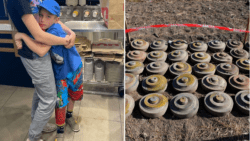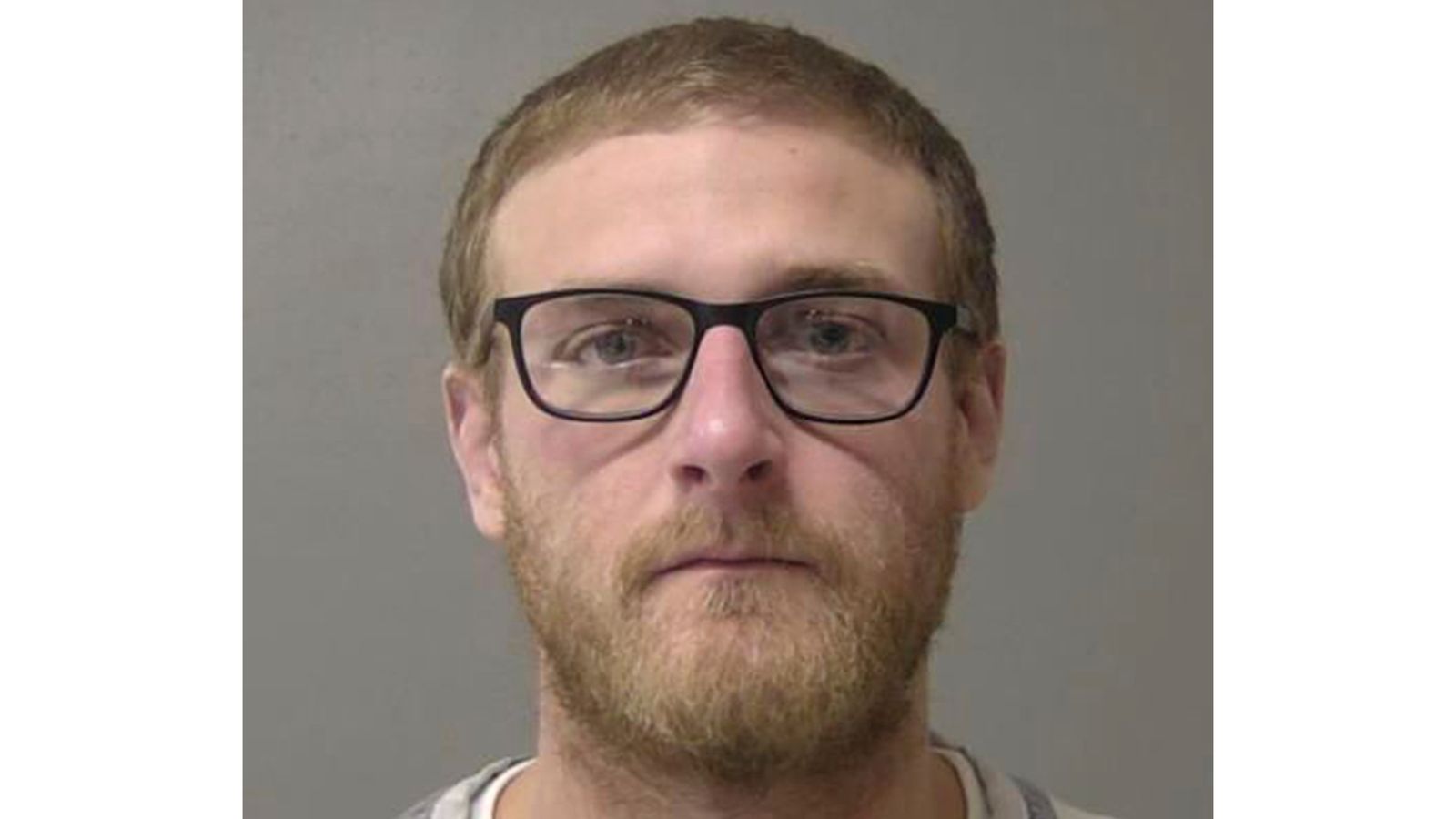Civilians in Ukraine and Karabakh experience the same suffering from the impact landmines (Picture: Foundation Kharkiw With You/ANAMA, demining agency Azerbaijan)
Lethal anti-personnel landmines currently contaminate around 174,000 square kilometres of Ukrainian territory – and their repercussions will be felt for the next 30 years, experts have predicted.
However, such mines have not only been seeded in 11 of the 27 regions of Ukraine, but also massively litter the land in Karabakh, Azerbaijan, where they have been installed by Armenian troops for decades.
At a recent international conference in Berlin, focusing on the medical, psychological and legal cost of these deadly explosive weapons, medical experts and landmine survivors spoke about the ongoing devastation they cause.
One young person who shared their story was 8-year-old Bogdan Ponomariov. He told the room how he had been running to help his father when a mine went off. The blast was so severe that the little boy lost his leg.
Meanwhile, Rustam Maggeramov, an ethnic Azeri who has lived in Ukraine for the past 20 years, spoke about what he’d witnessed as a volunteer providing assistance to both civilians and the Ukrainian military.
Magerramov, who had his own business in Mykolaiv, delivered food, medicine and ammunition to Ukrainian defenders at his own expense, often feeding families of Ukrainians living in the territories occupied by Russian troops.
8-year-old Bogdan told how his leg had been blown off by a mine after running to help his father (Picture: Foundation Kharkiw With You)
His own brother had been killed during the liberation of Karabakh, and Maggeramov told the audience how he felt the realities of Azerbaijan and the Ukrainian cities under attack have all but merged into one.
‘The same thing is happening in Karabakh,’ he explained. ‘I look at Bogdan, and I see Gismet, whom he reminds me of. He was a 11 years old Azerbaijani boy, who was blown up by a mine buried in a pasture in liberated Karabakh region of Kelbajar.’
Alongside Bogdan and Maggeramov at the ‘Bonded By Pain’ conference, were Dr Sofia Tkazky, a member of the British Psychological Society; Dr Sven Mardian, Senior Consultant and Head of Trauma Surgery at the Charité Hospital Berlin; Merl Florstedt, Head of Corporate Communications, Ottobock SE & Co. KGaA; and other Ukrainian and Azerbaijani volunteers.
One of the main concerns discussed was that any landmine planted today could go on to create unthinkable damage for many years to come.
The long-lasting impact of deadly anti-personnel landmines was discussed as part of the Bonded By Pain conference in Berlin (Picture: Jonny Wen)
Landmines aren’t just an issue in Ukraine, ones such as above litter the land in Karabakh, Azerbaijan (Picture: ANAMA, demining agency Azerbaijan)
The panel of experts spoke about how victims of anti-personnel mines were not limited to those who have been killed or injured by them; but their relatives and neighbours also became victims in their own right.
The group relayed how those impacted by war stop trusting the most basic, familiar features of the world around them: from being scared to open the door of an entrance hall, or go to a cemetery to visit the graves of relatives, to simply stepping off a well-trodden, safe path onto the grass to collect a stray ball.
Meanwhile, they said, this hostile environment simply becomes the fabric of everyday life, as parents are forced to raise their children in a place surrounded by objects that have been familiar since childhood, from houses to parks to swings, yet carry the risk of sudden death.
Dr Sofia Tkazky, a member of the British Psychological Society, spoke at length about the emotional damage of living in fear of landmines (Picture: Jonny Wen)
The panel also warned that such trauma would linger on and affect more than one generation, through panic attacks and disruption of healthy psychological defence mechanisms.
It was additionally highlighted that it wasn’t just the victims of landmine seeded areas that were affected either – those who plant anti-personnel mines were rarely left physically and emotionally unscathed.
‘In conventional warfare, modern anti-personnel mines were originally intended to be used by soldiers against soldiers and not against civilians – and we are now watching the unconventional methods of warfare,’ Dr Tkazky said during the panel discussion.
‘Mines are hidden in children’s toys, like Armenian or Russian soldiers do in Karabakh and Ukraine. Cemeteries where people come to commemorate the dead have been mined. Residential houses are also mined. They are placed in such a way that as many civilians as possible are destroyed.
[VIDEO HERE]
It is an act of genocide because it is an attempt to kill people because of their ethnicity or nationality,’ she added.
Last year Germany took over the leadership of the signatory states of the Ottawa Treaty aimed at eliminating anti-personnel landmines. Currently 164 states have acceded to it, however major powers, which are also past and current manufacturers of landmines and include the USA, China and Russia, are not parties to the treaty.
The process of demining Ukraine, according to the conference experts, may take as long as 30 years. They added that it will take just as long to clear the Azerbaidjani region of Karabakh from the Armenian mines.
Ivan Sokol, director of the Department of Civil Defense of the Ukrainian military-civilian administration of the Kharkiv region, said that 1.25 million hectares of land are considered a hazard in his region alone. People can’t go back to their homes, drive on the roads or simply move around.
Ivan Sokol, director of the Department of Civil Defense of the Ukrainian military-civilian administration of the Kharkiv region (Picture: Foundation Kharkiw With You)
‘Russian troops have been laying mines for 15 months now, minefields are layering on top of each other,’ he told the conference.
‘Most of all, the civilian population suffers from them. Russian soldiers are digging mines deeper, throwing leaves at them. They are difficult to detect, and they do not work immediately, but when the soil is compacted from driving and walking along the roads. That is, the territory will already be considered safe and free from mines when such a “surprise” suddenly explodes.’
Sokol also warned that Ukrainians simply do not have enough civilian sappers to help with the demining process as some tragically die or get seriously injured.
‘We desperately need special equipment for demining, because almost every day people die who just want to return to their homes,’ he explained. ‘We know that Turkish minesweepers MEMATT are used in Azerbaijan, they are not cheap. But we have developed a machine ourselves in Kharkov – it removes 99% of anti-personnel mines, which reduces the workload of sappers greatly.
‘Almost every day people die who just want to return to their homes,’ said Ivan Sokol (Picture:Foundation Kharkiw With You)
‘We assemble such special equipment ourselves – in several workshops and factories. Development is ongoing and we are looking for parts for the machines. We also repair them ourselves, so that they continue to work faster.
The Kharkiv region is an example of a symbiosis of government and volunteers. Communication and coordination between government agencies, volunteer organizations and international donors has been established. Thanks to this, we ourselves work with volunteer structures so that there is no bureaucratic red tape, we contact sponsors directly to speed up the production of such equipment.
‘We train the operators of these machines ourselves. Such a machine costs about 150 thousand dollars – we are looking for funds to build more such equipment.’
An Azerbaijani sapper gets to work in Karabakh (Picture: ANAMA, demining agency Azerbaijan)
Sokol also reported that the Azerbaijanis, who returned to their land in Karabakh, have gained a lot of experience in demining civilian objects in three years.
‘Our countries have suffered from the same criminal activities as en-masse mining,’ he said. ‘We are ready to exchange experiences, we are ready to show our machines to Azerbaijan, to create them together, since we have a common pain – civilians, children, old people, women are dying.”
Meanwhile, In Kharkiv, money is being raised to fund the largest possible number of local special equipment for demining.
Those who want to have a hand in saving the civilian population can apply directly to the Ukrainian fund ‘Kharkiv with You’, which is conducting a large-scale fundraising program for mine clearance in the Kharkiv region and the purchase of special minesweepers.
At the conference, 8-year-old Bogdan told how his leg had been blown off by a mine after running to help his father.





